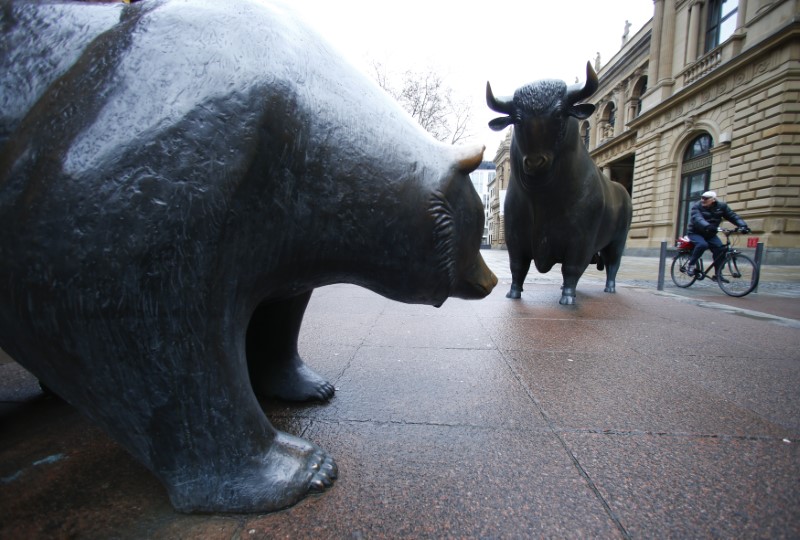By Sujata Rao and Ritvik Carvalho
LONDON (Reuters) - World markets entered 2018 speculating that the most synchronized global economic expansion in a decade was about to overheat but growth has since proved underwhelming.
While missile strikes and threats of a global trade war have hogged the headlines, it's an unexpected loss of economic momentum, particularly in Europe, that has frightened investors who played down political risks for years and stayed firmly focused on brisk economic growth and rising corporate profits.
The recent surge in oil prices, adding inflation to the economic mix, may also weigh further on markets assessing whether a slowdown is afoot, or if the first quarter was merely a soft patch before the boom resumes.
"For the first time in 18 months, markets no longer have the protective shield of growth momentum," said Luca Paolini, chief strategist at Pictet Asset Management, who so far considers the soft economic data an air pocket.(GRAPHIC-Global economic growth: https://reut.rs/2KeDwYj)
"There is not enough evidence to say this is the beginning of the end, yet if you look at fundamentals, there is deterioration relative to last year, no question about that."
Big multilateral forecasters remain broadly optimistic. The International Monetary Fund predicts robust 3.9 percent growth for 2018 and next year, though it too warned last week of risks from trade tensions or the waning impact of U.S. tax cuts.
Data this week showed euro zone business morale worsened further in April, while German authorities have cut growth forecasts after business confidence hit its lowest level in more than a year.(GRAPHIC-Global manufacturing PMIs: https://reut.rs/2JjV5oO)
U.S. first-quarter gross domestic product (GDP) data due on Friday is predicted by the latest Reuters polls to show a 2.2 percent expansion, down from a forecast in March of 2.6 percent growth.(GRAPHIC-Economic Surprise Index: https://reut.rs/2KcD0dt)
Adding to investors' concerns are warnings from companies such heavy equipment maker Caterpillar Inc. (N:CAT), which said on Tuesday its forecast-beating first-quarter profits and sales were probably a high watermark for the year.
Richard Turnill, global chief investment strategist at BlackRock, told clients equities would continue to do well but he predicted lower returns and higher volatility than in 2017, partly because there was "less room for growth to top expectations."
REASONS TO BE CAUTIOUS
So where, besides Europe's faltering Purchasing Managers' Indexes (PMIs), are concerns about growth evident?
Perhaps most illustrative are government bonds in Western countries where yield curves, the gap between short- and long-term interest rates, have inexorably narrowed all year - a fairly reliable indicator of growth pessimism.
Some of the curve flattening has reversed slightly after the oil price jump increased inflation worries and lifted long-term yields. But the gap between U.S. 2-year and 10-year yields remains almost 30 basis points below the highs hit this year.
"I don't think the curve is telling us anything different from other indicators," Pictet's Paolini said. "It's telling you that over the next one to two years there is reason to be cautious."
Shipping market bellwether, the Baltic Dry Freight Index (BADI), fell to eight-month lows this month and while it has rebounded in recent days, it is still 20 percent off its December highs.
Copper, another growth barometer, has come off four-year highs hit late in 2017
Then there are indexes that estimate how much pessimism or optimism is priced into markets, based on how often data beat or miss forecasts, and by how much. Perhaps the most closely watched is Citi's Economic Surprise Index, which has slumped into the red after hitting 7-1/2-year highs at the end of 2017. (GRAPHIC-Economic Surprise Index: https://reut.rs/2KcD0dt)
And finally, equities. After a record 15-month winning streak, world stocks are 7 percent below end-January highs (MIWD00000PUS).
Even more telling, U.S. shares in so-called defensive sectors such as telecoms and utilities have modestly outperformed cyclicals such as technology stocks since mid-March, Morgan Stanley (NYSE:MS) analysts said last week.
Defensive stocks usually fare better during downturns while cyclicals thrive in booms. The slight shift may indicate, "economic growth is likely peaking not accelerating at this point in this cycle", Morgan Stanley told clients.
BACK IN SYNC
What if markets are reading it wrong?
Most still believe that while growth has stuttered rather than roared into 2018, a powerful expansion continues nonetheless. Seasonal adjustments after a long and severe Northern hemisphere winter, early Easter holidays and China's New Year, may also be to blame.
Barclays (LON:BARC), for instance, believes U.S. growth did lose steam in the first quarter and has downgraded its forecasts. But it sees "residual seasonality" also playing a role.
Even though the U.S. government's Bureau of Economic Analysis has adjusted its methodology to account for seasonal factors, they still cause weak reported growth in the first quarter each year and buoyant activity later, Barclays said.
In Europe too, analysts have blamed weak data on one-offs such as the harsh winter, Easter vacations and high sick levels of sick leave due to flu.
Finally, some such as Sebastian Raedler at Deutsche Bank (DE:DBKGn) don't see indicators, market levels and growth forecasts as out of kilter. Instead, purchasing manager indexes were over-optimistic from late 2017, especially in the euro zone, he said.
"PMIs and GDP growth move very closely in line with each other, but suddenly this gap opened up between GDP running at 2.5 percent and PMIs implying 4 percent growth," Raedler said.
According to Raedler, growth remains firm but the rate of change in growth looks less certain.
"If it's the rate of change then that matters, then that has just started to roll over... and we have seen the impact on stock and bond markets."
